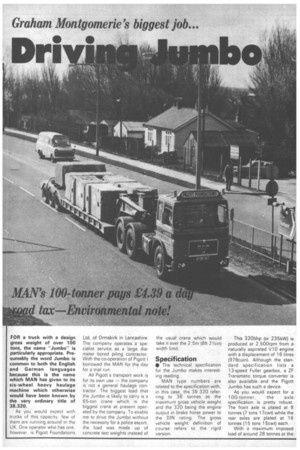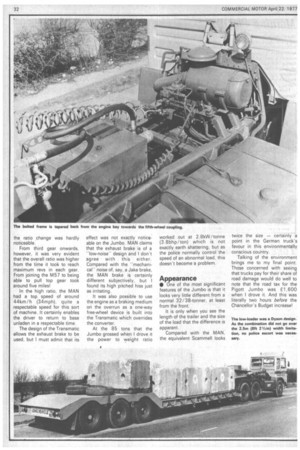FOR a truck with a design gross weight of over
Page 32

Page 33

Page 34

If you've noticed an error in this article please click here to report it so we can fix it.
100 tons, the name "Jumbo" is particularly appropriate. Presumably the word Jumbo is common to both the English and German languages because this is the name which MAN has given to its six-wheel heavy haulage machine which otherwise would have been known by the very ordinary title of 38.320.
As you would expect with trucks of this capacity, few of them are running around in the UK. One operator who has one, however, is Pigott Foundations Ltd, of Ormskirk in Lancashire. The company operates a specialist service as a large diameter bored piling contractor. With the co-operation of Pigott I borrowed the MAN for the day for a trial run All Pigott's transport work is for its own use -the company is not a general haulage contractor. The biggest load that the Jumbo is likely to carry is a 65-ton crane which is the biggest crane at present operated by the company. To enable me to drive the Jumbo without the necessity for a police escort, the load was made up of concrete test weights instead of
the usual crane which would take it over the 2.5m (8ft 21/2in) width limit.
Specification
• The technical specification for the Jumbo makes interesting reading.
MAN type numbers are related to the specification with, in this case, the 38,320 referring to 38. tonnes as the maximum gross vehicle weight and the 320 being the engine output in brake horse power to the DIN rating. The gross vehicle weight definition of course refers to the rigid version.
This 320bhp (or 235kW) is produced at 2,500rpm from a naturally aspirated V10 engine with a displacement of 16 litres (976cuin). Although the standard specification lists a 13-speed Fuller gearbox, a ZF Transmatic torque converter is also available and the Pigott Jumbo has such a device.
As you would expect for a 100-tonner, the axle specification is pretty robust. The front axle is plated at 8 tonnes (7 tons 17cwt) while the rear axles are plated at 16 tonnes (15 tons 15cwt) each.
With a maximum imposed load of around 28 tonnes at the fifth-wheel, this gives a maximum train weight of 105 tonnes (103 tons). As if this were not enough. MAN claims that an even higher gross weight can be met to specific order!
Pigott has got the first right-hand-drive Jumbo to be built. Although Pickfords have a number of these trucks, they have gone for the left-handdrive version complete with sliding doors
Technique
• The first thing that I noticed about driving the MAN was how easy it was to handle.
It was the first time that I had driven anything approaching 85 tonnes in weight, but the effect of the payload was negligible as far as handling was concerned. In fact it was just like driving a "standard" 32 /38-tonner On the corners the ZF power-steering made it extre mely easy for the driver so at no time was I conscious of the total weight the outfit was pulling which may or may not be a good thing.
The technique for driving with the Transmatic was quite straightforward.
Basically the unit consists of a six-speed ZF gearbox with the addition of the WSK 400 torque converter. At the recommendation of Billy Huyton, the Jumbo's regular driver, I start ed off at this weight in second gear. "Depress the clutch, shove it into second then
release the clutch immediately and you'll just sit there,he
said. "When you're ready to go, just accelerate and you're away.'" I must admit that I found it extremely difficult to accept that I could select the gear I wanted in the conventional manner, immediately let the clutch out and stay where I was.
Although I have driven automatic trucks before, the situation there is completely differ ent as the selector operates in a distinctive pattern and there is no clutch pedal. With the ZF Transmatic in the Jumbo, there is a conventional clutch pedal as well as the familiar MAN steering column gearchange.
In the Transmatic assembly there are two clutches -one is a lock-up clutch which mechanically overrides the torque converter and the other is a separating clutch mounted at the rear of the converter.
When the driver depresses the clutch pedal, it operates this separating clutch which is used purely for selecting individual gears, not for starting or stopping. This is taken care of by the torque converter The lock-up clutch comes into operation at a predetermined engine speed which in the case of the Jumbo was around 1,400rpm. If the road speed and thus the engine speed falls below a set level, the torque converter will cut in again. A kick-down facility means that the driver can override the lock-up clutch to a certain extent. On the MAN I rarely needed the kickdown anyway.
Pulling away
• So, to pull away from rest I depressed the clutch selected second and then let out the clutch.
To move off, it was simply a question of flooring the throttle when the torque converter took up the drive and we were away. Simple — just like the man said.
Moving off at this weight was very similar to being clumsy with the clutch pedal on a truck with a conventional transmission.
You know the sort of situation I mean. If you feed in too much power or are too violent with the clutch, the cab will bounce around. With the MAN the cab immediately reared up as the drive was taken up and there it stayed until the lock-up mechanism operated.
Although the torque converter will allow the truck to be driven completely as an automatic, it is not to be recommended when running at the sort of weights we were using. Apart from starting from rest, I drove the Jumbo as though it had a standard manual gearbox using the clutch pedal and the gear lever both up and down the box.
Performance
• On normal A-roads with a fair amount of stopping and starting and roundabouts to contend with, the MAN was in the deep reduction ratio of the ZF transfer box. This gave it a maximum speed of around 35km / h (22mph).
For motorway type running, the high ratio can be selected simply by flicking a switch on the instrument panel although this must be done while the truck is stationary. So under normal operating conditions, the driver has to pull on to the hard shoulder when joining a motorway, come to a complete standstill, change the ratio and move off again.
At slow speeds the effect of continued overleaf
the ratio .change was hardly noticeable.
From third gear onwards, however, it was very evident that the overall ratio was higher from the time it took to reach maximum revs in each gear. From joining the M57 to being able to pull top gear took around five miles!
In the high ratio, the MAN had a top speed of around 44km/h (34mph), quite a respectable speed for this sort of machine. It certainly enables the driver to return to base unladen in a respectable time.
The design of the Transmatic allows the exhaust brake to be used, but I must admit that its
effect was not exactly noticeable on the Jumbo. MAN claims that the exhaust brake is of a -low-noisedesign and I don't agree with this either. Compared with the -mechanicalnoise of, say, a Jake brake, the MAN brake is certainly different subjectively, but I found its high pitched hiss just as irritating.
It was also possible to use the engine as a braking medium on the overrun as a one-way free-wheel device is built into the Transmatic which overrides the converter.
At the 85 tons that the Jumbo grossed when I .drove it the power to weight ratio worked out at 2.8kW/torme (3.8bhp/ton) which is not exactly earth shattering, but as the police normally control the speed of an abnormal load, this doesn't become a problem.
Appearance
• One of the most significant features of the Jumbo is that it looks very little different from a normal 32/38-tanner, at least from the front.
It is only when you see the length of the trailer and the size of the load that the difference is apparam.
Compared with the MAN, the equivalent Scammell looks twice the size — certainly a point in the German truck's favour in this environmentady conscious country.
Talking of the environment brings me to my final point. Those concerned with seeing that trucks pay for their share of road damage would do well to note that the road tax for the Pigott Jumbo was £1,600 when I drove it. And this was literally two hours before the Chancellor's Budget increase!




















































































